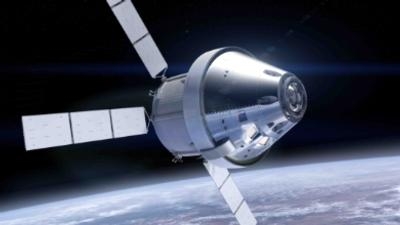More Than 20,000 Parts Make Up The European Service Module
Airbus Defense and Space has started assembling the European Service Module (ESM), a key element of NASA’s next-generation Orion spacecraft that will transport astronauts into deep space for the first time since the end of the Apollo program.

In November 2014, Airbus Defense and Space was chosen by the European Space Agency (ESA) as prime contractor to develop and build the ESM, which will supply propulsion, power, thermal control, air and water for astronauts on missions beyond the Moon and to Mars. The ESM sits below the Crew Module.
Integrating more than 20,000 parts and components in the ESM flight model ranging from electrical equipment to rocket engines, solar arrays, tanks for propellant and life support consumables as well as hundreds of meters of cables and tubes marks a major milestone for the Orion program. After the arrival of the flight model structure from Thales Alenia Space Italy the assembly is being carried out at Airbus Defense and Space’s site at Bremen, Germany, where officials from ESA, NASA, Airbus Defense and Space and partners gave an update on the Orion program’s progress on May 19.
“With the Orion Service Module, we are part of an historic space mission,” said François Auque, Head of Space Systems. “We will make sure this mission is a success, working hand in hand with our customers ESA and NASA and our industrial partner Lockheed Martin Space Systems.”
The second test flight of the Orion vehicle and its first atop NASA’s Space Launch System rocket known is known as Exploration Mission-1. This 2018 mission will be un-crewed and travel more than 64,000 km beyond the Moon to demonstrate the spacecraft’s performance. The first crewed mission, Exploration Mission-2, will be launched as early as 2021.
The Orion spacecraft is designed to take humans further than they have ever been before. The exploration vehicle will carry the crew to space, provide emergency abort capability, sustain the crew during space travel, and provide safe re-entry from deep space return velocities. Orion ushers in a new era of space exploration, with missions envisaged beyond the Moon, to an asteroid mass delivered to lunar orbit and Mars.
The ESM is cylindrical in shape and about four metres in diameter and in height. It features the ATV’s distinctive four-wing solar array (19 metres across unfurled) that generates enough electricity to power two households. Its 8.6 tonnes of propellant will power one main engine and 32 smaller thrusters. The ESM has a total mass of just over 13 tonnes. In addition to the main propulsion capability for the Orion spacecraft, the ESM will perform orbital maneuvering and attitude control functions. It also provides the main elements of the life support system such as water and oxygen for the crew while providing power and thermal control while it is docked to the crew module. The unpressurised service module can also be used to carry additional cargo.
(Image provided with Airbus Defense and Space news release)
 Sierra Space Repositions Dream Chaser for First Mission
Sierra Space Repositions Dream Chaser for First Mission ANN's Daily Aero-Term (05.10.24): Takeoff Roll
ANN's Daily Aero-Term (05.10.24): Takeoff Roll Aero-News: Quote of the Day (05.10.24)
Aero-News: Quote of the Day (05.10.24) Aero-News: Quote of the Day (05.11.24)
Aero-News: Quote of the Day (05.11.24) ANN's Daily Aero-Term (05.11.24): IDENT Feature
ANN's Daily Aero-Term (05.11.24): IDENT Feature



